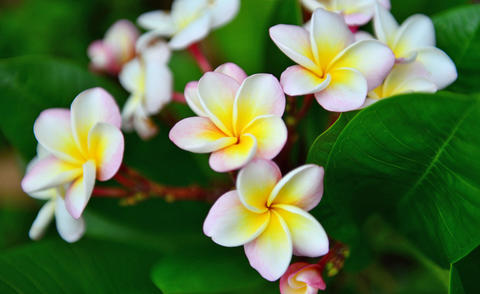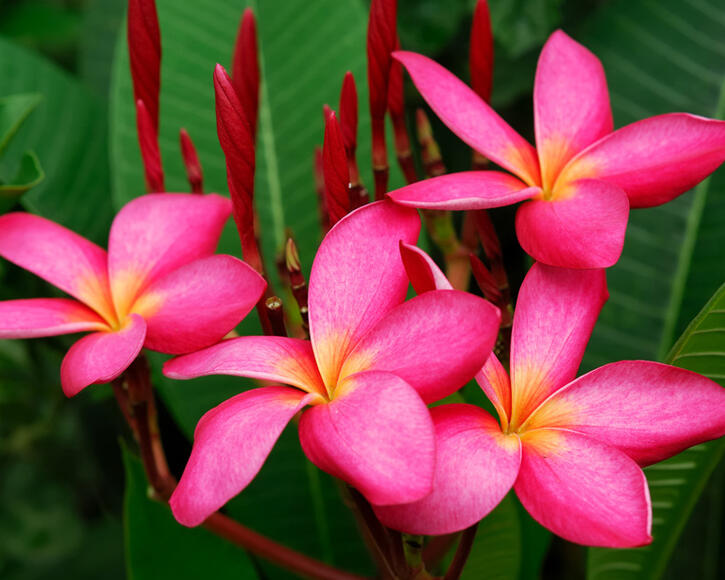Frangipani, Plumeria
The Frangipani is eye-catching with its extraordinary and fragrant flowers. Here’s how to plant and care properly for this exotic flowering wonder.
Factsheet
- Growth type
-
- shrub
- Succulent
- Growth height (from)
- from 500 cm to 700 cm
- Growth width (from)
- from 300 cm to 500 cm
- Growth characteristics
-
- sweeping
- upright
- multi-trunked
- Flower color
-
- yellow
- red
- pink
- Flowering time (month)
-
- June to September
- Flower shape
-
- 5-fold
- terminal
- Trumpets
- Flower characteristics
-
- strongly fragrant
- Leaf color
-
- green
- page format
-
- elliptiques
- oblong
- Fruit shape
-
- Bellows fruit
- Light
-
- sunny
- Soil type
-
- sandy to loamy
- Soil Moisture
-
- moderately dry to fresh
- ph value
-
- neutral
- Lime compatibility
-
- lime-tolerant
- Nutrient requirements
-
- nutrient-rich
- Humus
-
- rich in humus
- Decorative or utility value
-
- Flower Decoration
- Leaf ornaments
- Scented plant
- Climate zones according to USDA
-
- 10
- Use
-
- Planters
- Winter garden
- Warm House
- Garden style
-
- Pot garden
The red frangipani (Plumeria rubra), also known as West Indian jasmine or temple tree, is a species of plant from the dog venom family (Apocynaceae) and is native to Puerto Rico, Mexico and the Lesser Antilles. The genus Plumeria includes about eight species of deciduous or semi-evergreen shrubs with succulent shoots and fleshy branches. Frangipani is said to have been cultivated in the imperial gardens of Vienna as early as 1770, where they bloomed every year. For the inhabitants of the West Indies, the plant is a symbol of immortality. Their aromatic, fragrant flowers are often used to make perfumes.
The Frangipani is a large, deciduous shrub with thick trunks. In the natural habitat it can be up to 22.96 feet high and 53.80 feet wide, but in a pot it rarely reaches heights of more than 9.82 feet. The milky sap found in the plant parts is poisonous.
The alternate leaves of the Frangipani, located at the end of the branches, are elliptical to oblong or inverted lanceolate. They become 7.87 inches to 15.74 inches long and up to 5.90 inches wide. On the midrib, the medium-green leaves are often pale in color and, in contrast to the species Plumeria alba, have a distinct nerve running around the edge.
From June to September, salver-shaped, 2.75 to 3.93 inches wide, waxy flowers appear in terminal panicles and loosely spread umbels. The flowers of the Frangipani are pink-red, sometimes yellow or red and have a very strong fragrance. The five short stamens are attached to the base of the tube and neither the short stigmas nor the two carpels are visible from the outside.

Two elongated follicle fruits with many seeds are formed from each plumeria flower.
The Frangipani needs a sunny, warm and humid location all year round - a warm or greenhouse is best, in which the tropical plant thrives well at 68 degrees Fahrenheit. Even during the summer, the plumeria only needs moderate soil moisture, but high humidity.
Standard soil is sufficient as a substrate for the plumeria. However, provide a drainage layer so that the water can drain off properly.
It is important to water the frangipani carefully but vigorously, especially in summer. Always allow the soil to dry well between waterings. A prerequisite for planting buds is that they should not be planted during the dormant period from November to April. During this time you should only water sparingly. Although the Frangipani will shed its leaves during this time, there is no need to worry - the briefly desolate sight is made up for by a magnificent bloom next summer.

During the summer months you can feed the Frangipani every one to two weeks with commercially available flower fertilizer, which you add to the water in half the concentration specified on the packaging.
If the vessel has become too small, you can put the plumeria in a larger pot in spring. It is repotted about every two to five years. Don’t forget the drainage layer.
You can trim the main shoot several times to the desired height so that a crown forms. Later you just have to cut back a few branch that towers above the crown. In principle, however, a frangipani usually develops best without a cut, as every cut leaves unsightly wounds and also increases the susceptibility to fungal diseases.
During the dormant period between November and April you should overwinter the Frangipani in a bright place at a minimum of 50 degrees Fahrenheit. A conservatory works the best. The plant will lose many leaves and should only be watered moderately during this time.

Some varieties of Plumeria rubra are enchanting with different flower colors, such as the”Dulcemia” variety. Its fruity-scented flowers appear from soft pink to dark red depending on the sunlight. Plumeria rubra “Divine” has light pink-yellow flowers and is distinguished by its particularly high flowering potential.
Frangipani can be propagated by sowing or leafless cuttings AT 77 degree Fahrenheit. To do this, first cut off shoot tips that are at least 7.87 inches long from older trees with long branches. To prevent too much white milky sap from leaking out of the cut wounds of the plants, pass a lit match or the flame of a lighter is over the cut several times. In this way, the milky sap that has already leaked out dries faster and seals the wound. If this is too time-consuming, let the cuttings air dry for a day. On the following day, the pots intended for planting are filled with a mixture of two thirds of fresh planting soil and one third of coarse sand.
Lower the cuttings 0.78 to 1.57 inches deep into the soil. They are supported by two support rods and plastic-coated binding wire that does not cut into them. Water the cuttings well and place them in a warm place with 68 degrees Fahrenheit ground heat. In contrast to the standard practice, the cuttings are not covered. Keep the soil slightly moist, but not wet and by no means completely dry, for the following weeks. As soon as roots have formed, the young plant sprouts new leaves at the top.
If the air is too dry, there is a possibility of spider mites and mealybugs infestation.

